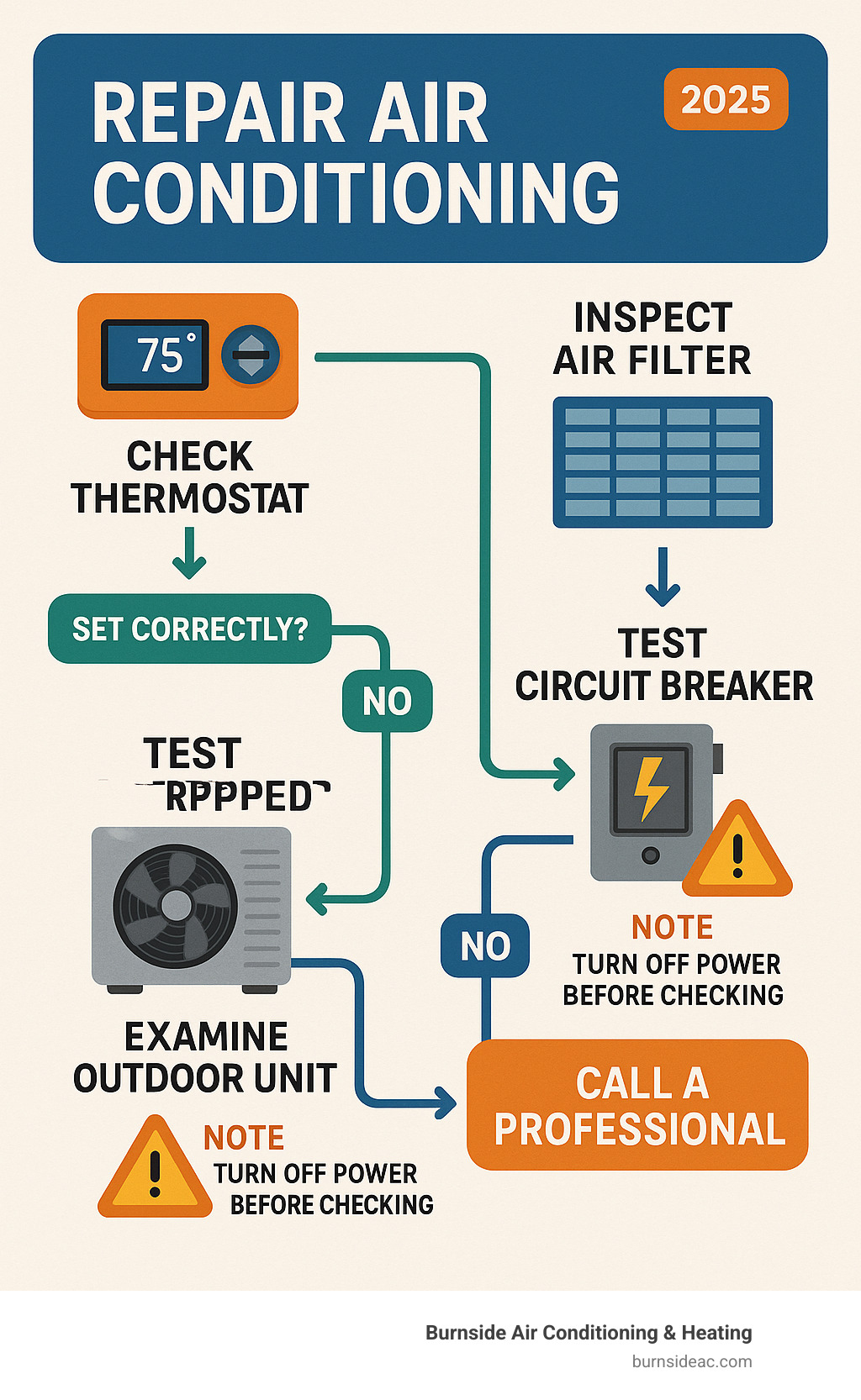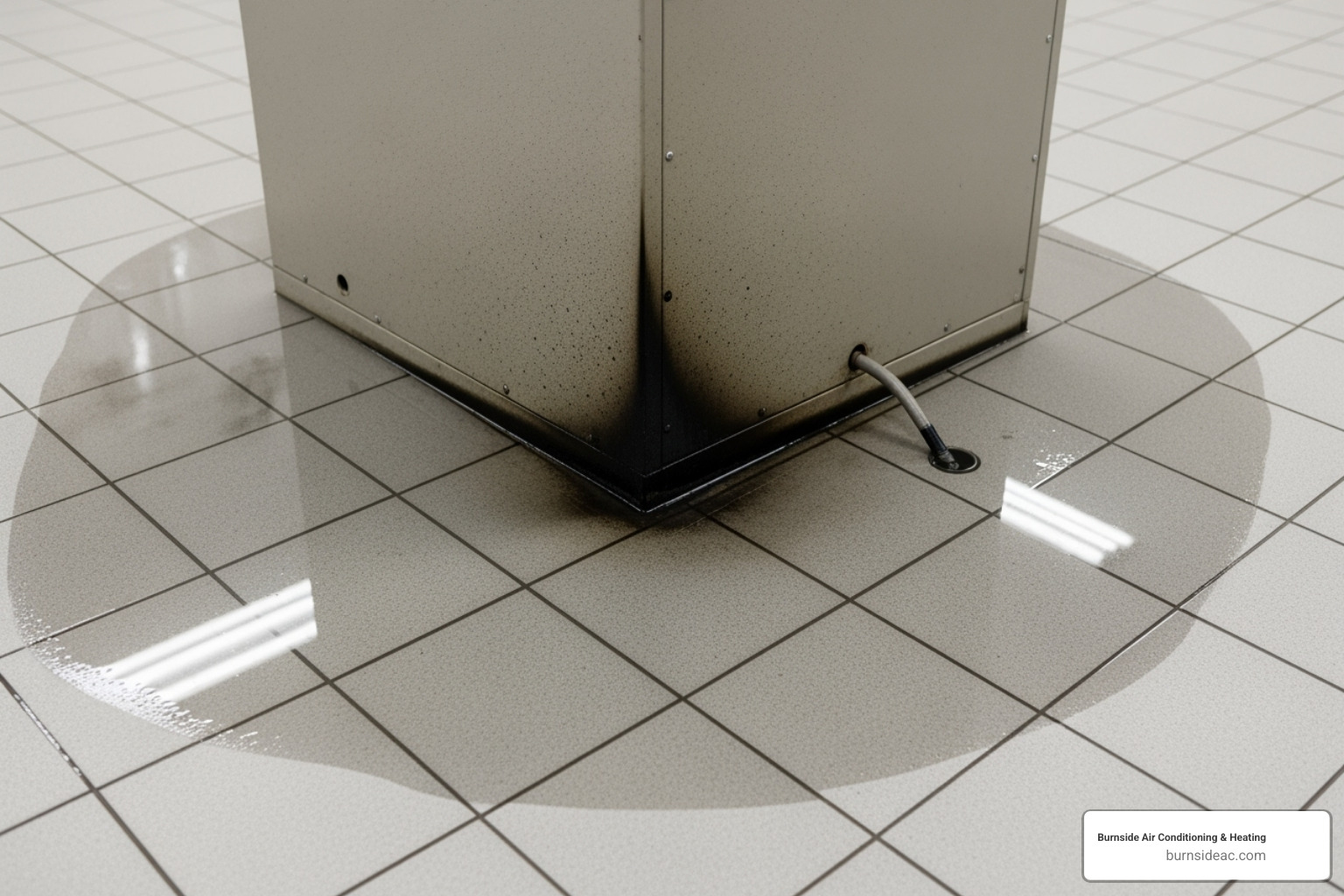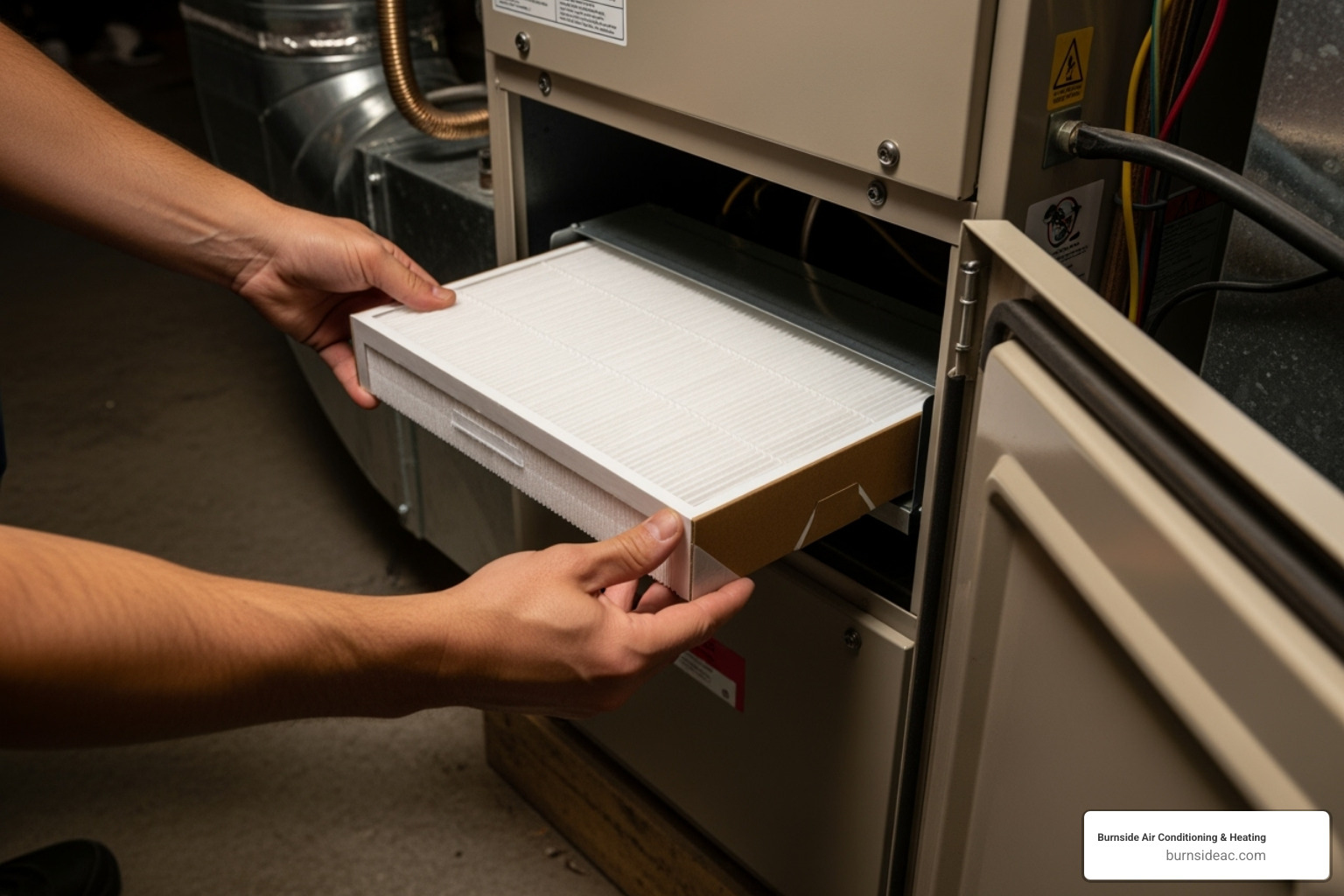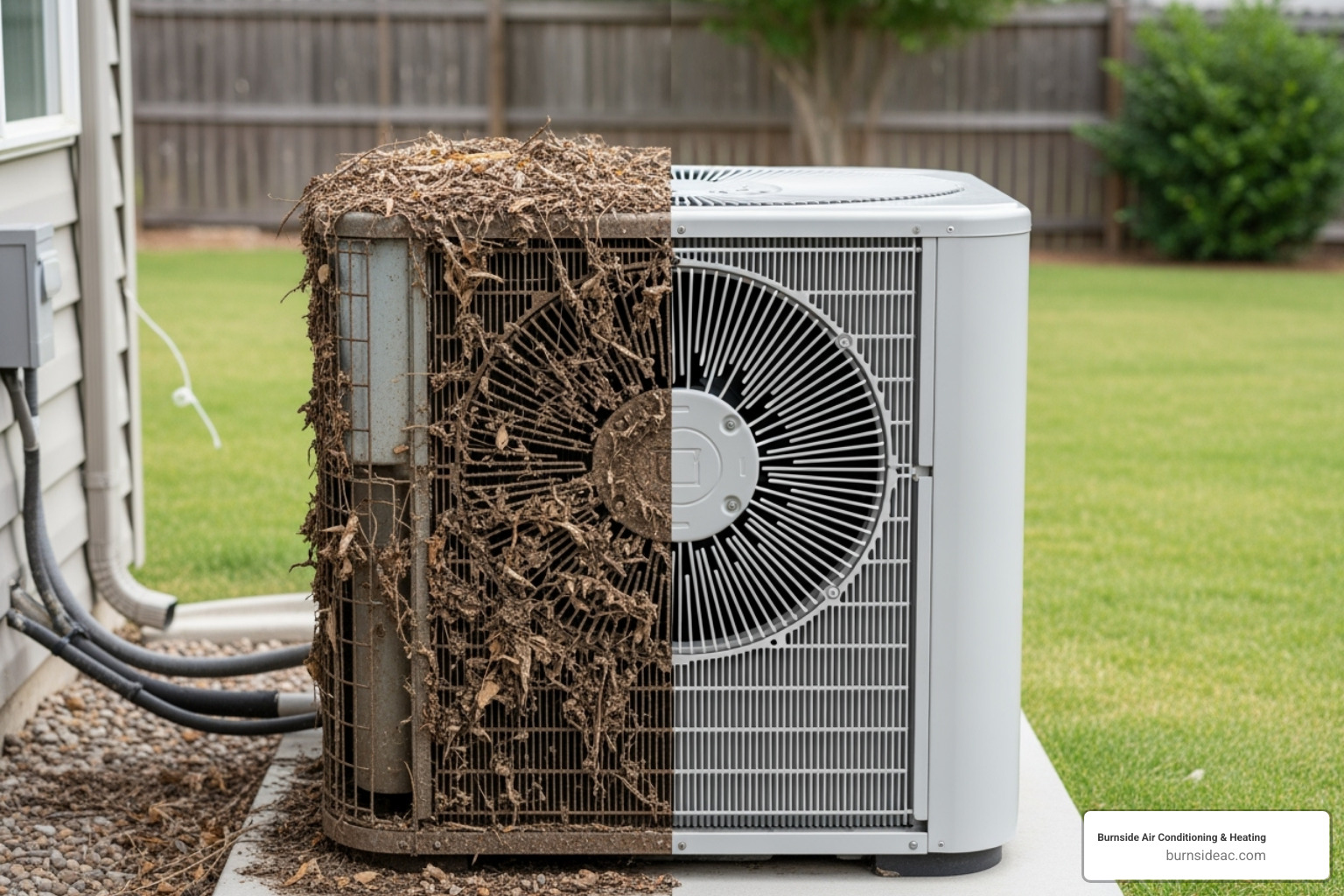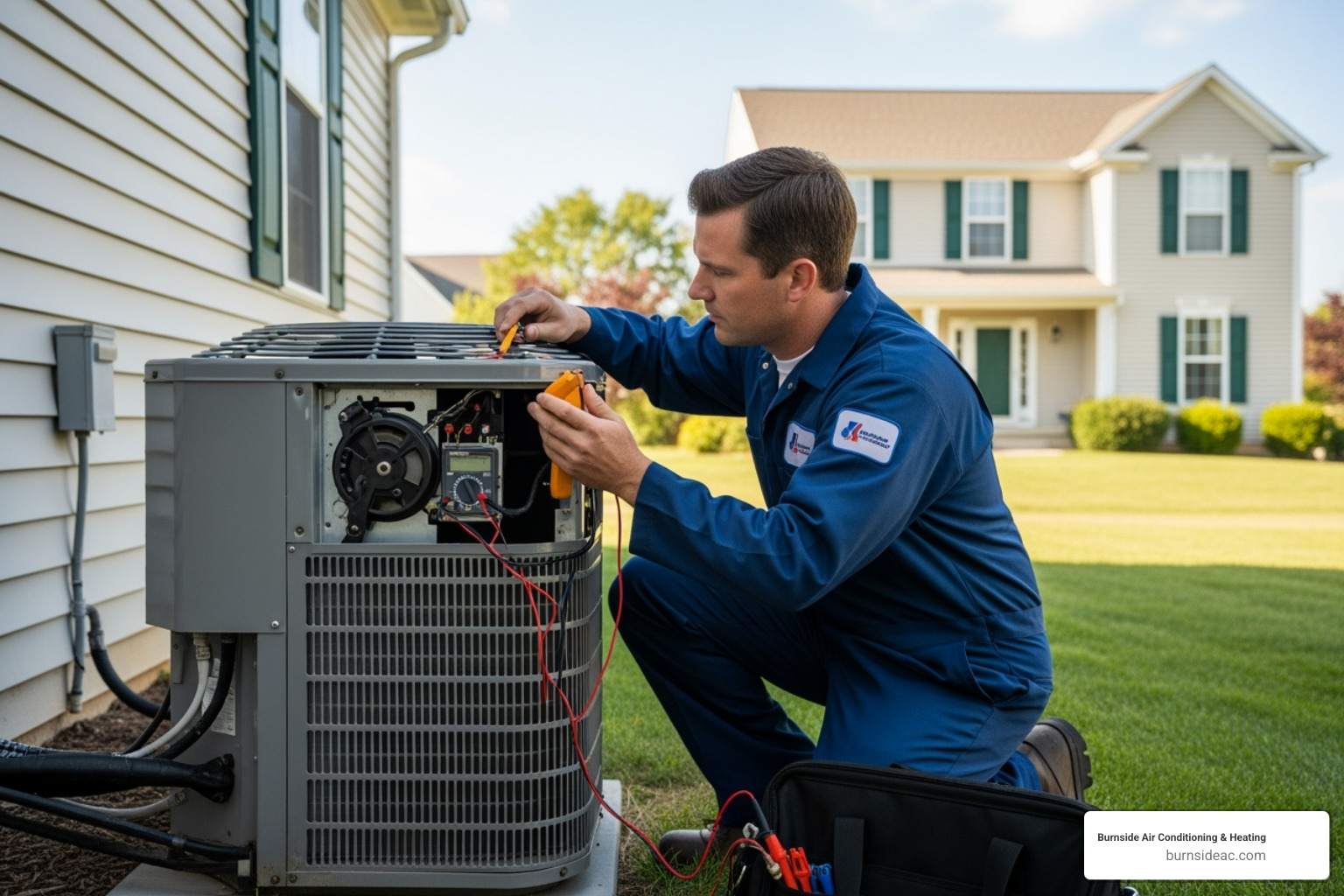
When Your AC Stops Working: Quick Solutions That Actually Work
When you need to repair air conditioning in your Collin County home, it’s often a crisis. An AC failure during a scorching Texas summer demands fast solutions.
Most Common AC Problems and Quick Fixes:
- Not cooling – Check thermostat settings and air filter first
- No power – Inspect circuit breaker and thermostat batteries
- Weak airflow – Replace dirty air filter or clear vents
- Water leaks – Clear clogged condensate drain line
- Strange noises – Turn off unit immediately and call a professional
- High humidity – Clean air filter and check refrigerant levels
The truth is, many AC problems have simple fixes. A clogged air filter causes about 80% of HVAC system failures, and other issues like tripped breakers or wrong thermostat settings are easy to resolve.
What matters most is knowing when to DIY and when to call for help. Some repairs, like handling refrigerant or electrical parts, are dangerous without proper training and require a professional.
Learning basic troubleshooting can save you time, money, and discomfort.
Is Your AC on the Fritz? Telltale Signs of Trouble
Your AC usually gives warning signs before it quits. Recognizing them early can prevent expensive headaches. Watch for these telltale signs:
- Weak or Warm Air: If you feel a weak, warm breeze from your vents instead of a cool blast, your system is struggling.
- Strange Noises: Your AC should hum quietly. Pay attention to unusual sounds. Grinding or squealing often points to failing motor bearings. Buzzing can signal electrical issues, while clanking suggests a loose part. Continuous clicking may indicate a faulty relay.
- Unusual Odors: A musty smell usually means mold or mildew in the drain line or evaporator coil. A burning smell is a serious red flag for an overheating motor or wiring—turn the unit off immediately.
- Water Leaks: Puddles around your indoor unit indicate a problem, most often a clogged condensate drain line.
- High Humidity: If your home feels sticky even with the AC on, the system isn’t removing moisture properly.
- Frequent Cycling: If your AC turns on and off more than usual (short cycling), it’s working too hard, wasting energy and straining components.
- High Energy Bills: A sudden spike in electricity costs often means your AC’s efficiency has dropped, a common sign it needs to be repaired.
Your First-Aid Kit: DIY AC Troubleshooting and Minor Fixes
Many common AC problems have simple solutions you can handle yourself. Before calling for service, try these DIY fixes to get your cool air flowing again. We’ll cover checking the thermostat, changing the air filter, resetting the breaker, and cleaning the main components. While these tasks are doable, safety is paramount when you repair air conditioning issues.
Safety First: Essential Precautions for DIY AC Repair
Air conditioners have high-voltage components. Always take these safety precautions:
- Turn Off Power: Shut off the AC’s circuit breaker at your main electrical panel.
- Use the Disconnect: Turn off the power at the outdoor unit’s disconnect block as well.
- Test for Power: Use a voltage tester to confirm the power is off before touching any wiring.
- Beware of Capacitors: Capacitors can hold a charge even when the power is off. Consult your owner’s manual for how to safely discharge them.
- Wear Protective Gear: Always use safety glasses and gloves.
Simple Fix #1: Check Your Thermostat and Breaker
Start with the basics. Dead thermostat batteries are a common culprit. Also, ensure the thermostat is set to “Cool” and the temperature is set lower than the current room temperature. Next, check your electrical panel for a tripped breaker. To reset it, push it firmly to “off” before flipping it back to “on.” If it trips again immediately, call a professional. Many systems have a built-in delay of up to 10 minutes to protect the compressor.
Simple Fix #2: Clean or Replace Your Air Filter
A clogged filter is responsible for up to 80% of HVAC breakdowns. It restricts airflow, forcing your system to work harder, which increases energy bills and can cause the evaporator coil to freeze. Find your filter in the furnace/air handler or a return air vent. Replace it monthly during heavy use, especially if you have pets or allergies.
Simple Fix #3: Clear the Condensate Drain Line
Water pooling near your indoor unit usually means a clogged condensate drain line, often due to algae buildup. This can lead to water damage. To clear it, find the drain line access cap near your indoor unit. Pour a cup of distilled vinegar or a 1:16 bleach-to-water solution into the line. Wait 30 minutes, then flush with water. For tough clogs, use a wet/dry vacuum on the outdoor end of the pipe to suck out the blockage.
Simple Fix #4: Clean the Outdoor Condenser Unit
Your outdoor condenser unit collects dirt, leaves, and grass clippings, which coat the condenser fins and trap heat, reducing efficiency. To clean it, first cut all power at the breaker and the outdoor disconnect. Remove large debris by hand. Then, use a garden hose (not a pressure washer) to gently spray the fins from the inside out. If fins are bent, you can straighten them with a fin comb from a hardware store.
When to Call a Professional for Air Conditioning Repair
Some AC problems require professional expertise. Air conditioners contain high-voltage electricity and pressurized refrigerants, which are dangerous to handle without proper training and tools. Attempting complex repairs can cause more damage and void your warranty. Call a certified technician for:
- Complex diagnostics after trying basic DIY fixes.
- Any electrical issues beyond a breaker reset.
- Refrigerant problems like leaks or recharging.
- Major component failures (compressor, motors).
- Persistent mechanical noises.
- Anytime you feel unsafe performing a repair.
Electrical Issues: Capacitors, Contactors, and Motors
Electrical components like capacitors, contactors, and motors are common failure points. A failed capacitor may cause the unit to hum without starting. A faulty contactor can prevent the outdoor unit from turning on at all. Fan motor issues or compressor problems (indicated by loud grinding) are serious and require professional diagnosis and repair.
Refrigerant Problems: Leaks and Recharging
Hissing sounds, a frozen evaporator coil, or poor cooling performance often signal a refrigerant leak. Handling refrigerant is technical and legally restricted. Per EPA regulations, only certified technicians can legally purchase, handle, and charge these substances to prevent environmental harm. This is especially true for older R-22 refrigerant. A professional won’t just “top off” a leaking system; they will find and fix the leak, then recharge the system to precise specifications, which is crucial for performance and legality.
Understanding the Costs of Professional Air Conditioning Repair
The cost to repair air conditioning varies by the issue. Most companies charge a service call fee for diagnosis, which is often applied to the final repair cost. Capacitor replacements are typically affordable, while fan motor and compressor replacements are more expensive. Refrigerant leak repair costs vary based on the leak’s location and the type of refrigerant needed (older R-22 is much costlier than modern R410A). At Burnside Air Conditioning & Heating, we use flat-rate pricing, so you know the full cost before we begin work—no surprises.
The Big Decision: Repair or Replace Your AC Unit?
When facing a major repair, you must decide: is it worth fixing, or should you invest in something new? The answer depends on several factors that we’ve helped countless Collin County homeowners steer.
Age and Efficiency
Most AC units have a lifespan of 10 to 15 years. If your unit is in that range or older, replacement is a strong consideration. Modern units are far more efficient. A new unit with a high SEER rating (14 or higher) can significantly cut your cooling costs compared to an older model (10 SEER or less). If your system uses R-22 refrigerant, which is being phased out and is expensive to source, replacement is often the smarter long-term choice when you need to repair air conditioning.
Cost Analysis: When a Repair Isn’t Worth It
Use the “50% rule”: if a repair costs half or more than a new system, replacement is usually the better financial choice. This is often the case with major component failures like the compressor or evaporator coil. If you’re facing frequent breakdowns and rising repair bills, investing in a new, reliable system with a warranty makes more sense than patching up an old one. The long-term energy savings and peace of mind from a new system can be surprisingly cost-effective.
Frequently Asked Questions about AC Repair
Here are the most common questions we get from Collin County families, with our honest answers.
How can I prevent my air conditioner from breaking down?
The best way to avoid an emergency repair air conditioning call is with preventative care. Annual professional maintenance is key; a technician can spot issues before they become emergencies. At home, the most important task is to change your air filter regularly (usually monthly during cooling season) and keep your outdoor condenser unit clear of leaves and debris.
How long does a typical AC repair take?
It depends on the problem. Simple repairs like replacing a capacitor or clearing a drain line often take just an hour or two. Complex issues like finding a refrigerant leak or replacing a motor can take several hours. We stock common parts to ensure fast service, but if a special part is needed, we’ll provide a clear timeline.
Is it more cost-effective to repair or replace an AC that uses older refrigerant?
If your AC uses R-22 refrigerant, you’re in a tough spot. R-22 is being phased out and is extremely expensive. For an R-22 unit over 10-12 years old needing a major repair (especially one involving a leak), replacement is almost always more cost-effective. A new, efficient system will save you money on energy bills and future repairs, providing better comfort and peace of mind.
Stay Cool and Comfortable with a Reliable AC
You’re now equipped to handle many common AC issues. The key is safety first. Simple fixes like changing filters are great DIY tasks, but electrical and refrigerant work is for professionals.
Regular preventative maintenance is your best defense against surprise breakdowns. An annual tune-up and clean filters can extend your system’s life and keep energy bills down.
When you need professional repair air conditioning services in Collin County, you need a team that’s fast and reliable.
That’s where Burnside Air Conditioning & Heating steps in. Since 1958, our family-owned company has provided McKinney and surrounding areas with dependable service and guaranteed workmanship. Your comfort can’t wait.
Whether you have a leak, hear strange noises, or need to decide between repair and replacement, our trusted professionals are a phone call away.
Get expert HVAC service in Frisco, TX
Stay cool, and don’t hesitate to reach out for expert help. Your AC (and your family) will thank you for it.
